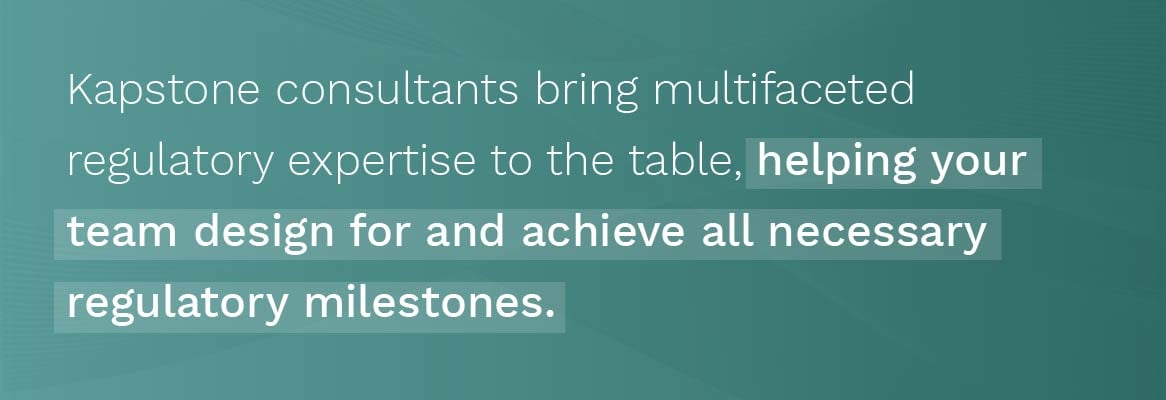A Conversation With David Walsh | Director of Engineering

According to David Walsh, Director of Engineering at Kapstone, medical device companies really only have one goal: to “make sure their device is ultimately widely accepted in the market, easily understood, and can be used safely and effectively.” Sums it up, doesn’t it?
No matter a device company’s area of interest or expertise, their ultimate goal is to carry their unique product through medical device design & development, testing, regulatory approval, and commercialization—and get that device to the patients and practitioners who need it.
However, the steps to achieving these goals are not that simple in practice. Bringing a device through the full development and commercialization lifecycle can take significant time—not to mention effort and resources. From concepting to prototyping, regulatory submission to production, these complex steps can be obstacles for established and startup device companies alike.
Here at Kapstone, we’re well versed in every stage of the medical device development lifecycle. Our experts provide full-service medical device consulting, stepping into your projects at multiple entry points to ensure that your team and process are optimized for success. Today, we’ll be discussing our approach to the first two phases of a project (which include activities for design, development, and initial testing) with David, whose experience in device engineering allows him to lend a thoughtful and practical perspective.

Assessing the Intellectual Property During the Product Development Lifecycle
Kapstone consultants work with many companies on numerous device types, but we approach every project with the “same level of professionalism, expertise, and sense of potential.” When we receive a new proposal, we immediately start working to understand the product’s market potential, engineering and design challenges, and any potential regulatory roadblocks. Given the breadth of our experience, we’re able to make these assessments in-house (or we know someone knowledgeable about your field, we guarantee it).
Evaluating the current intellectual property landscape is perhaps the most important part of our initial research and discovery. We start by researching existing patents and patent applications, assessing not only what’s already on-market, but also what could be in the product development pipeline. The results of these assessments are particularly important for the smaller device companies we work with, who, for one reason or another, may not be able to compete in a densely populated market. Though it’s their job to tell us what makes their product both “new and useful,” David argues, it’s Kapstone’s job to help companies understand the landscape in which that may or may not be true—and how to adapt their product if that need arises.
“When we embark on a project,” David notes, “we want to make sure that we’re providing something of value to our client—not just something that avoids other people’s intellectual property, but is a novel way of approaching a problem.” Through initial IP research, we identify niche market opportunities for our clients that help them not only solve pressing medical problems, but also establish their own intellectual property. “In order to do that,” David summarizes, “we have to understand the existing IP landscape—where there is room for new ideas, and where the field is already too crowded.”
Example queries we can help you resolve:
- What challenge does your product resolve, and are there other solutions available?
- What differentiates your product in the marketplace?
- How can you adapt your approach to avoid potential infringement?
- How have competitors addressed similar design or procedural challenges?
- And more—ask your consultant for specifics.

The Role of Regulatory Affairs Expertise in Device Development
Like top notch medical devices, the Kapstone approach is very intentionally designed. Our process is meant to supplement your internal team wherever and whenever you need support, adapting over time as those needs evolve. We’re equipped to consult on numerous components of device development very early in the process—not only intellectual property, as discussed, but also product quality and regulatory adherence. David notes that it’s “important to bring, at minimum, a broad regulatory strategy into the project early, as stringent regulatory guidelines can influence decisions at the outset of device development.” Kapstone consultants bring multifaceted regulatory expertise to the table, helping your team design for and achieve all necessary regulatory milestones.
The first and most important step is to place your product in the current regulatory landscape. In the United States (and to varying degrees elsewhere), medical device approvals can be expedited if a device is proven to be substantially equivalent to an approved product, or predicate. Kapstone consultants work with your team to “identify predicate devices with the same indications, similar materials, or similar technologies,” finding the path of least resistance towards approval. These measures, if successful, can substantially reduce the time, effort, and budget required for a project.
(To learn more about substantial equivalence in the US, check out our recent blog)
David notes that, of course, it’s “always possible to develop a medical device that uses new materials, processes, or technologies.” However, when devices are novel in indication, intended use, material composition, or other factors, it’s important to structure the project appropriately. New devices can be much more expensive to test and bring to market, given that they are likely to require intensive clinical trials and further evaluations to prove “biocompatibility and strength.” Our consultants are equipped to work on fully novel projects, but they can also help your team identify opportunities to simplify the path to regulatory approval. Sometimes, the difference between “new” and “substantially equivalent” is as minor as using a different material or changing a component of the indication. Our experts can help you find and optimize towards those nuances.
All in all, we recommend that a regulatory strategy for your device be incorporated into your workflow as early as possible, as it is much more challenging (not to mention costly) to change a product’s design later in the process. As David puts it: “identifying potential predicates early in the project helps us make design decisions, as well as balance competing priorities, in a cheaper and more efficient way.”

Prototyping & Testing The Importance of Prototyping & Testing During the Medical Device Development Lifecycle
The benefits of rudimentary prototyping and testing are perhaps underappreciated. Modeling technologies have become much more advanced in recent years, allowing some device engineers to run computer simulations on their products without ever feeling the physical device in hand. David notes that while it may be easy for these engineers to make the mental leap from 3D screen modeling to a device’s weight, material feel, and how it will fit together, it’s much more difficult to convey these features to non-engineers—particularly clinicians.
Here at Kapstone, we believe that it is critical to develop prototypes at scale. Why? Well, “we’ve found that allowing our clients and testing populations to hold the product in their hands is the best illustration of the concepts we’re trying to discuss.” Consider the hypothetical example of a novel hip replacement fashioned from a lighter material. Modeling that device onscreen is one thing, but for a clinician to truly grasp the benefits, they need to...well, grasp the benefits in their hands. Only then can they provide appropriate, useful feedback on the device’s potential. Our consultants can connect you to the latest physical modeling technologies to support prototyping needs.
On that note, Kapstone also advocates and helps to arrange for early, targeted testing. This approach to product testing takes into account something that many manufacturers overlook: the potential for human error. David explains that because human factors are actually “being emphasized in new regulatory guidelines in both the United States and Europe,” device companies who proactively test and design for potential human error are at a significant market advantage. The appropriate testing for a device depends on who will ultimately be using the product—be it a surgeon with a high degree of expertise or a patient at home with none. In other words, we recommend getting the product into the hands of those who will actually be using it, and collecting their input as to how its design may need to be adjusted. This approach is also known as simulated use testing, and it’s the best way to ensure that your device is intuitive for its intended audience.
Though Kapstone consultants are trained to support any (or every) stage of the medical device development lifecycle, we bring particular expertise to the development stage. Our strategies for intellectual property research, regulatory affairs, and prototyping and testing can help your company hit the ground running the right way—and at the right speed. The earlier you involve our multidisciplinary experts, the better-equipped we’ll be to help you achieve that core goal of getting your device accepted in the market, easily understood, and used safely and effectively.
Intrigued? We’d love to work with you. Get in touch or learn more about our affordable approach.



